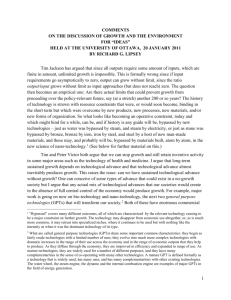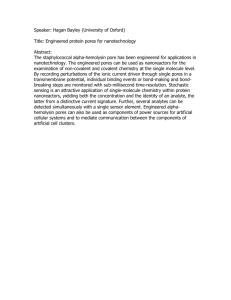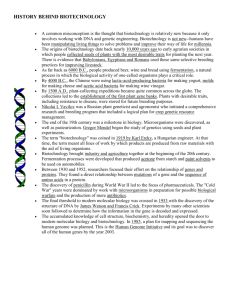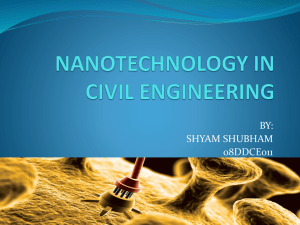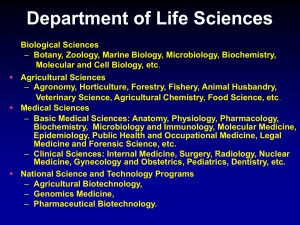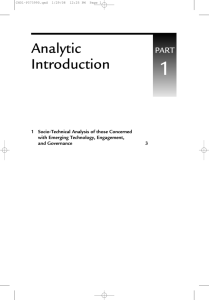404-1477-1-PB
advertisement
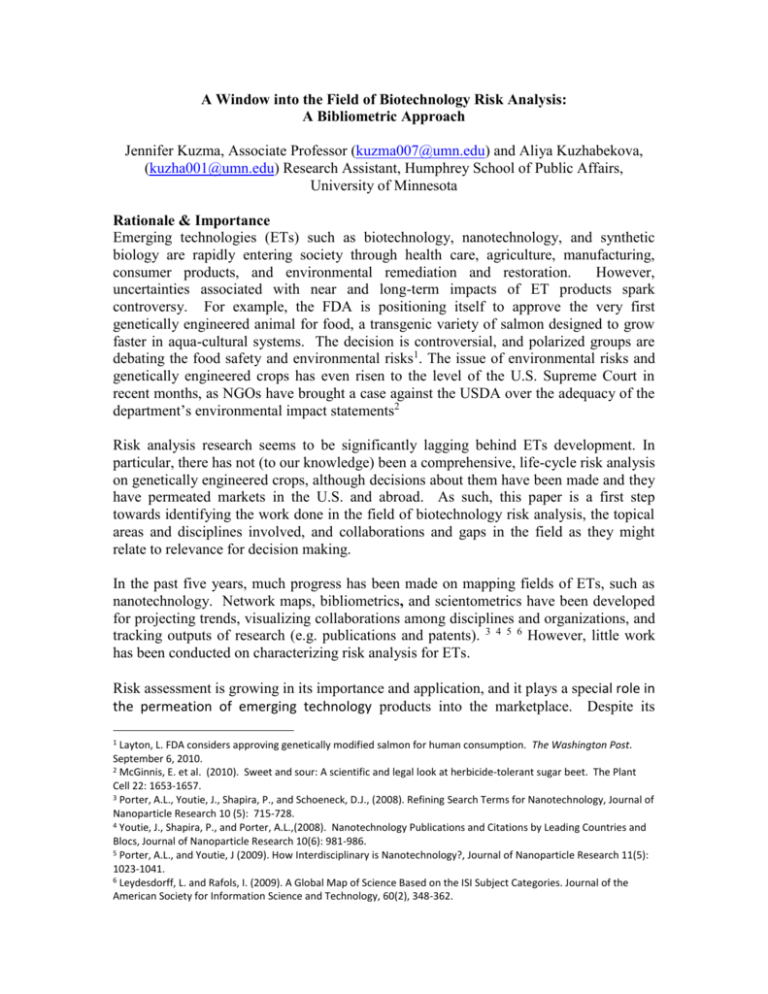
A Window into the Field of Biotechnology Risk Analysis: A Bibliometric Approach Jennifer Kuzma, Associate Professor (kuzma007@umn.edu) and Aliya Kuzhabekova, (kuzha001@umn.edu) Research Assistant, Humphrey School of Public Affairs, University of Minnesota Rationale & Importance Emerging technologies (ETs) such as biotechnology, nanotechnology, and synthetic biology are rapidly entering society through health care, agriculture, manufacturing, consumer products, and environmental remediation and restoration. However, uncertainties associated with near and long-term impacts of ET products spark controversy. For example, the FDA is positioning itself to approve the very first genetically engineered animal for food, a transgenic variety of salmon designed to grow faster in aqua-cultural systems. The decision is controversial, and polarized groups are debating the food safety and environmental risks1. The issue of environmental risks and genetically engineered crops has even risen to the level of the U.S. Supreme Court in recent months, as NGOs have brought a case against the USDA over the adequacy of the department’s environmental impact statements2 Risk analysis research seems to be significantly lagging behind ETs development. In particular, there has not (to our knowledge) been a comprehensive, life-cycle risk analysis on genetically engineered crops, although decisions about them have been made and they have permeated markets in the U.S. and abroad. As such, this paper is a first step towards identifying the work done in the field of biotechnology risk analysis, the topical areas and disciplines involved, and collaborations and gaps in the field as they might relate to relevance for decision making. In the past five years, much progress has been made on mapping fields of ETs, such as nanotechnology. Network maps, bibliometrics, and scientometrics have been developed for projecting trends, visualizing collaborations among disciplines and organizations, and tracking outputs of research (e.g. publications and patents). 3 4 5 6 However, little work has been conducted on characterizing risk analysis for ETs. Risk assessment is growing in its importance and application, and it plays a special role in the permeation of emerging technology products into the marketplace. Despite its 1 Layton, L. FDA considers approving genetically modified salmon for human consumption. The Washington Post. September 6, 2010. 2 McGinnis, E. et al. (2010). Sweet and sour: A scientific and legal look at herbicide-tolerant sugar beet. The Plant Cell 22: 1653-1657. 3 Porter, A.L., Youtie, J., Shapira, P., and Schoeneck, D.J., (2008). Refining Search Terms for Nanotechnology, Journal of Nanoparticle Research 10 (5): 715-728. 4 Youtie, J., Shapira, P., and Porter, A.L.,(2008). Nanotechnology Publications and Citations by Leading Countries and Blocs, Journal of Nanoparticle Research 10(6): 981-986. 5 Porter, A.L., and Youtie, J (2009). How Interdisciplinary is Nanotechnology?, Journal of Nanoparticle Research 11(5): 1023-1041. 6 Leydesdorff, L. and Rafols, I. (2009). A Global Map of Science Based on the ISI Subject Categories. Journal of the American Society for Information Science and Technology, 60(2), 348-362. importance, we know very little about the portfolio of risk analysis research for ETs. In this paper, we use bibliometric methods to better understand the portfolio of risk analysis research for agricultural biotechnology7 with the goal of identifying gaps that are important for decision making and risk management. Identifying these gaps should be useful for developing funding policies in order to improve risk analysis for societal decision making. Approach As phase 1 and a starting point of this project, we are asking the following questions: What are the disciplines in the field of agricultural biotechnology risk assessment and what is their prominence? What are key topic areas and their prominence? What organizations are involved in this work? What is the extent of collaboration in the field? What are the organizational affiliations of the collaborators and non-collaborators? In order to address these questions, we used a bibliometric approach similar to that of Youtie et al (2011) in their previous work on nanotechnology and Environmental Health and Safety (EHS) research.8 We first developed search terms relevant to agricultural biotechnology risk analysis and tested them. The ISI Web of Knowledge Science Citation Index and Social Science Citation Index were searched from 1975 to 2010 for articles with the search terms in the titles. The search terms were refined iteratively to increase the relevance of the articles to agricultural biotech risk analysis9. A dataset of approximately 600 articles with approximately 5% irrelevance was decided upon for analysis. Irrelevant articles were removed prior to analysis. Data on articles were analyzed using a combination of Vantage Point software and Excel. Preliminary Results The number of biotechnology risk analysis publications per year increased substantially from 1979 to 2007 with a slight decline in recent years. It is not clear whether this trend is expected to continue. Affiliations of the authors are diverse, with no institution having more than 15 records. They also reflect a mix of government, academe, research institutes, and industry organizations. Authors come from over 50 countries, although only 15 countries had over 10 records. Subject categories of the journals as a measure of disciplines involved in the field were examined.10 The top five SCs were Biotechnology and Molecular Biology, Food Science and Technology, Toxicology, Plant Science, and Environmental Sciences. We are currently exploring multiple ways to assess the extent of collaboration among multiple disciplines in biotech risk analysis from the database, including citation analysis, co-author departmental affiliations, and keywords. 7 Agricultural biotechnology, under our definition, includes genetically engineered (GE) crops, GE food animals, GE farm-raised fish, and GE insects used for agricultural pest control. 8 Youtie, J. et al. (2011). The use of environmental, health, and safety research in nanotechnology research. J. Nanosci. Nanotechnol. 11, 1-9. 9 Note one of the co-authors has extensive experience in this area. 10 Youtie, J. et al. (2011). The use of environmental, health, and safety research in nanotechnology research. J. Nanosci. Nanotechnol. 11, 1-9.
